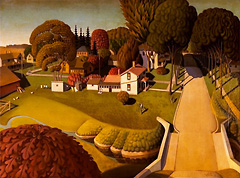Curriculum Materials: Art in America
|
|
Image 19 Grant Wood Questions: |
The Birthplace of Herbert Hoover, West Branch, Iowa
Wood's painting of Hoover's birthplace in West Branch, Iowa, is a satirical commentary on American myth-making. The artist represented the place as the tourist attraction it had become rather than as it looked at Hoover's birth in 1874. The small cottage where the president was born attracted many visitors who paid ten cents to tour it.
Wood depicts the historic site from a high vantage point on the crest of a hill. In the green valley below, a tour guide points to the cottage, located near a larger white house. A sign in front identifies it as Hoover's birthplace. Sunshine illuminates the large family homes, neatly mown lawns, and perfectly clipped trees in the quiet neighborhood surrounding the cottage. Many details - hanging laundry, toylike chickens, two boys in overalls, and a distant field of haystacks-round out this gentle rural scene.
Through his extensive European training,
Wood had developed a technique based
on a linear treatment of form and precise brushwork. Despite
this exacting technique, he consciously made his forms
appear simple. He simplified the boxlike houses to make
geometric shapes and treated the trees as solid, rounded
clumps of leaves. Through repetition, these enormous leaves
form decorative patterns. Likewise, the many tiny straight
brushstrokes that define the trim lawns create a rhythmic
pattern. Wood describes all of the
forms, whether close or distant, with the same degree of
detail and bathed in the same clear light, even though one
would not see them this way in nature. While everything in
the scene is recognizable, the overall effect of
Wood's painting resembles a
storybook world more than reality.
|
|
